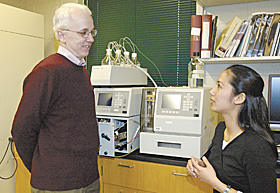Researchers Demonstrate Why
Lobster Shells Change Color
 |
| Harry Frank, professor of chemistry, with Robielyn Ilagan, a Ph.D. student, in the lab with high-speed laser equipment used to study the color of lobster shells. |
|
Photo by Dollie Harvey |
UConn chemistry professor and his colleagues have obtained experimental results that help answer the mystery of why most lobsters have a mottled brown shell (before cooking), and why the rare specimen is blue.
Harry Frank, professor of chemistry, says experiments by doctoral student Robielyn Ilagan in his research group support the theory that carotenoid molecules in the lobster’s shell interact with each other when bound in a protein. The resulting pigment-protein complex produces the lobster’s shell color.
In most cases, the combination of the red carotenoid molecules with the blue pigment-protein complex produces a shell that is mottled brown. In rare cases, the blue color of the protein predominates.
“It’s a mystery why these rare lobsters are blue and why brownish lobsters have the color they do,” says Frank. “Our data explain that.”
When a lobster is cooked, whether it is brown or blue in its live state, its shell turns red because the binding of the carotenoid molecule, astaxanthin, to the protein is broken, freeing the carotenoid to display its normal red color.
Frank has studied the structure and function of carotenoids since coming to UConn in 1980 and has had 19 years of continuous funding for his research from the National Institutes of Health. He says the experiments on the lobster protein began last year when his research group, together with his long-time collaborator, visiting professor Ronald Christensen of Bowdoin College, studied astaxanthin using a high-speed laser.
The laser, which has a flash duration of 100 femtoseconds – 10,000 times shorter than a nano-second – was purchased two years ago under a Major Research Instrumentation grant from the National Science Foundation to physics professor George Gibson, chemistry professor Robert Birge, and Frank.
The laser pulse is so rapid that the scientists could watch the astaxanthin molecule change under the light into an “excited” or high-energy state, and then relax back to its ground state. The observations enabled them to collect information about how the astaxanthin molecule interacts with its surroundings and with other astaxanthins.
Astaxanthin gives crustaceans their bright red color when cooked. How this happens was the subject of the Frank group’s research.
Lobsters accumulate astaxanthin in their shells and bind it with other astaxanthin molecules in a protein called alpha-crustacyanin, Frank says. The binding together of pairs of astaxanthin with the protein changes the normally red astaxanthin molecule to blue. The brownish-blue color of the native lobster arises from a combination of protein-bound and free astaxanthin in the lobster’s shell.
When a lobster is cooked, astaxanthin is released from the protein, but it stays in the shell and turns red in color. The association of the molecule with the alpha-crustacyanin protein shifts its light absorption spectrum and controls its color, Frank says.
In rare cases, a lobster “over-expresses” the alpha-crustacyanin protein, or has more than its normal share. The alpha-crustacyanin protein in its pure form is very blue, a rare color in nature.
The structure of the astaxanthin molecule bound in a smaller variant of the protein, beta-crustacyanin, was solved in 2003 by John Helliwell, a British scientist. This was a major breakthrough in understanding the coloration of lobsters, Frank says, but it didn’t explain the full story of why the color changes when the lobster is boiled or why the rare lobster is blue.
Recently a Dutch scientist, Arjan Van Wijk, proposed a model for the color change, based on quantum mechanical computations. Frank’s experimental results confirmed what Van Wijk’s computations projected.
Frank says the quest for the answer to the lobster’s shell color is akin to asking, “Why does grass have the different green hues that it does?” or “Why do autumn leaves have the color they do?”
“All of these biological coloration problems can be very complex,” he adds.
A scholarly article on the findings will appear in an upcoming issue of the Journal of Physical Chemistry.

